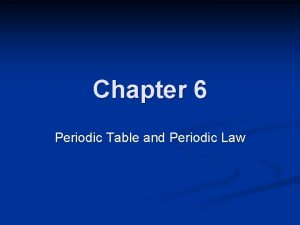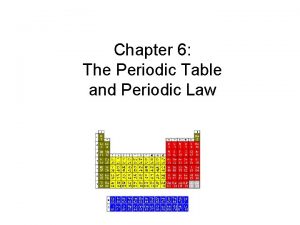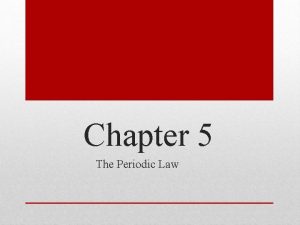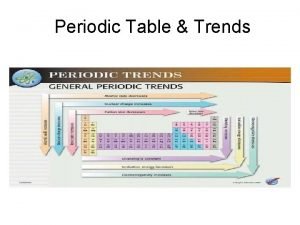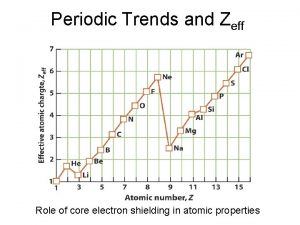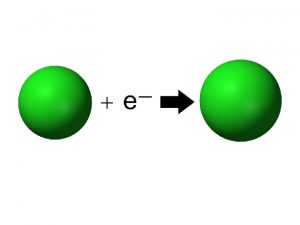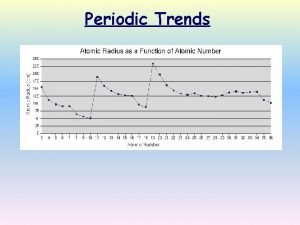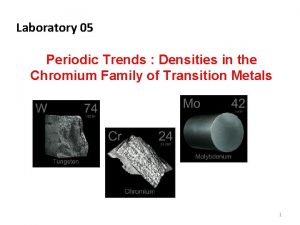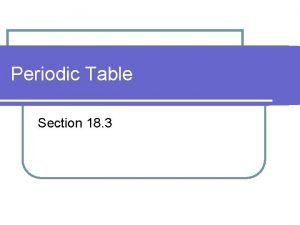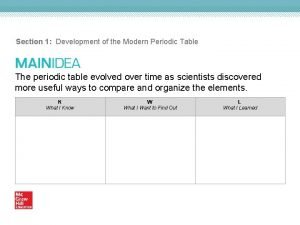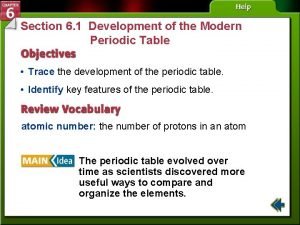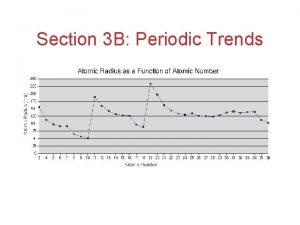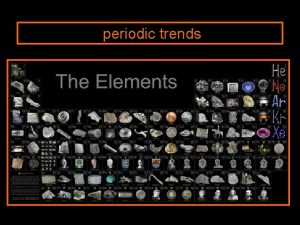Periodic Trends Chapter 6 Section 3 All Periodic


















































- Slides: 50

Periodic Trends Chapter 6 Section 3

All Periodic Table Trends • Influenced by three factors: 1. Energy Level – Higher energy levels are further away from the nucleus. 2. Charge on nucleus (# protons) – More charge pulls electrons in closer. (+ and – attract each other) • 3. Shielding effect

Trends in Atomic Size • Measuring an atom • First problem: Where do you start measuring from? • The electron cloud doesn’t have a definite edge. • They get around this by measuring more than 1 atom at a time.

Atomic Size } Radius • Measure the Atomic Radius - this is half the distance between the two nuclei of a diatomic molecule.

Atomic Size- Group Trends • As we increase the atomic number (or go down a group). . . • each atom has another energy level, • so the atoms get bigger. H Li Na K Rb

Atomic Size - Period Trends • Going from left to right across a period, the size gets smaller. • Electrons are in the same energy level. • But, there is more nuclear charge. • Outermost electrons are pulled closer. Na Mg Al Si P S Cl Ar

Trends in Atomic Size � In general, atomic size increases from top to bottom within a group and decreases from left to right across a period.

• Which alkali metal has an atomic radius of 238 pm? • How does atomic size change within a group? • Is a atom of Baruim, 56, smaller or larger than an atom of Cesium (Cs)

Ions • Some compounds are composed of particles called “ions” – An ion is an atom (or group of atoms) that has a positive or negative charge • Atoms are neutral because the number of protons equals electrons – Positive and negative ions are formed when electrons are transferred (lost or gained) between atoms

Ions • Metals tend to LOSE electrons, from their outer energy level – Sodium loses one: there are now more protons (11) than electrons (10), and thus a positively charged particle is formed = “cation” – The charge is written as a number followed by a plus sign: Na 1+ – Now named a “sodium ion”

Cation

Ions • Nonmetals tend to GAIN one or more electrons – Chlorine will gain one electron – Protons (17) no longer equals the electrons (18), so a charge of -1 – Cl 1 - is re-named a “chloride ion” – Negative ions are called “anions”

Anions

Trends in Ionization Energy • Ionization energy is the amount of energy required to completely remove an electron (from a gaseous atom). • Removing one electron makes a 1+ ion. • The energy required to remove only the first electron is called the first ionization energy.

Ionization Energy • The second ionization energy is the energy required to remove the second electron. – Always greater than first IE. • The third IE is the energy required to remove a third electron. – Greater than 1 st or 2 nd IE.

Table 6. 1, p. 173 Symbol First H He Li Be B C N O F Ne 1312 2731 520 900 800 1086 1402 1314 1681 2080 Second 524 7 7297 1757 2430 2352 2857 3391 3375 3963 Third 11810 14840 3569 4619 4577 5301 6045 6276

Symbol First H He Li Be B C N O F Ne 1312 2731 520 900 800 1086 1402 1314 1681 2080 Second 524 7 7297 1757 2430 2352 2857 3391 3375 3963 Third Why did these values increase so much? 11810 14840 3569 4619 4577 5301 6045 6276

What factors determine IE • The greater the nuclear charge, the greater IE. • Greater distance from nucleus decreases IE • Filled and half-filled orbitals have lower energy, so achieving them is easier, lower IE. • Shielding effect

Shielding • The electron on the outermost energy level has to look through all the other energy levels to see the nucleus. • Second electron has same shielding, if it is in the same period

Ionization Energy - Group trends • As you go down a group, the first IE decreases because. . . –The electron is further away from the attraction of the nucleus, and –There is more shielding.

Ionization Energy - Period trends • All the atoms in the same period have the same energy level. • Same shielding. • But, increasing nuclear charge • So IE generally increases from left to right. • Exceptions at full and 1/2 full orbitals.

First Ionization energy He H • He has a greater IE than H. • Both elements have the same shielding since electrons are only in the first level • But He has a greater nuclear charge Atomic number

First Ionization energy He l Li H Li has lower IE than H l more shielding l further away l These outweigh the greater nuclear charge Atomic number

First Ionization energy He l Be H Be has higher IE than Li l same shielding l greater nuclear charge Li Atomic number

First Ionization energy He H l. B Be Li B has lower IE than Be l same shielding l greater nuclear charge l By removing an electron we make s orbital half-filled Atomic number

First Ionization energy He H Be Li C B Atomic number

First Ionization energy He N H C Be Li B Atomic number

First Ionization energy He N H C O Be Li B • Oxygen breaks the pattern, because removing an electron leaves it with a 1/2 filled p orbital Atomic number

First Ionization energy He N F H C O Be Li B Atomic number

First Ionization energy He Ne N F H C O Be Li B • Ne has a lower IE than He • Both are full, • Ne has more shielding • Greater distance Atomic number

Ne First Ionization energy He N F H C O Be Li B l Na has a lower IE than Li l Both are s 1 l Na has more shielding l Greater distance Na Atomic number

Atomic number First Ionization energy

Trends in Ionization Energy � First ionization energy tends to decrease from top to bottom within a group and increase from left to right across a period.

• Which element in period 2 has the lowest first ionization energy? In period 3? • What is the group trend for first ionization energy for noble gases and alkali metals? • If you drew a graph for second ionization energy, which element would you have to omit? Explain?

Driving Forces • Full Energy Levels require lots of energy to remove their electrons. –Noble Gases have full orbitals. • Atoms behave in ways to try and achieve a noble gas configuration.

2 nd Ionization Energy • For elements that reach a filled or half-filled orbital by removing 2 electrons, 2 nd IE is lower than expected. 2 • True for s • Alkaline earth metals form 2+ ions.

3 rd IE • Using the same logic s 2 p 1 atoms have an low 3 rd IE. • Atoms in the aluminum family form 3+ ions. • 2 nd IE and 3 rd IE are always higher than 1 st IE!!!

Trends in Ionic Size- Cations • Cations form by losing electrons. • Cations are smaller than the atom they came from – not only do they lose electrons, they lose an entire energy level. • Metals form cations. • Cations of representative elements have the noble gas configuration before them.

Trends in Ionic Size- Anions • Anions form by gaining electrons. • Anions are bigger than the atom they came from – have the same energy level, but a greater area the nuclear charge needs to cover • Nonmetals form anions. • Anions of representative elements have the noble gas configuration after them.

Configuration of Ions • Ions always have noble gas configurations ( = a full outer level) • Na atom is: 1 s 22 p 63 s 1 • Forms a 1+ sodium ion: 1 s 22 p 6 • Same configuration as neon. • Metals form ions with the configuration of the noble gas before them - they lose electrons.

Configuration of Ions • Non-metals form ions by gaining electrons to achieve noble gas configuration. • They end up with the configuration of the noble gas after them.

Ionic Size- Group Trends • Each step down a group is adding an energy level • Ions therefore get bigger as you go down, because of the additional energy level. Li 1+ Na 1+ K 1+ Rb 1+ Cs 1+

Ionic Size- Period Trends • Across the period from left to right, the nuclear charge increases - so they get smaller. • Notice the energy level changes between anions and cations. Li 1+ B 3+ Be 2+ C 4+ N 3 - O 2 - F 1 -

Size generally increases Trends in Ionic Size

Trends in Electronegativity • Electronegativity is the tendency for an atom to attract electrons to itself when it is chemically combined with another element. • They share the electron, but how equally do they share it? • An element with a big electronegativity means it pulls the electron towards itself strongly!

Electronegativity- Group Trend • The further down a group, the farther the electron is away from the nucleus, plus the more electrons an atom has. • Thus, more willing to share. • Low electronegativity.

Electronegativity- Period Trend • • Metals are at the left of the table. They let their electrons go easily Thus, low electronegativity At the right end are the nonmetals. • They want more electrons. • Try to take them away from others • High electronegativity.


The arrows indicate the trend: Ionization energy and Electronegativity INCREASE in these directions

Atomic size and Ionic size increase in these directions:
 Period trends
Period trends 15/999 mass street periodic table, o 8
15/999 mass street periodic table, o 8 All periodic trends
All periodic trends Chapter 9 section 1 labor market trends
Chapter 9 section 1 labor market trends Name 3 points
Name 3 points The periodic table and periodic law chapter 6
The periodic table and periodic law chapter 6 The periodic table and periodic law chapter 6
The periodic table and periodic law chapter 6 Chapter 5 periodic law
Chapter 5 periodic law As atomic size
As atomic size Atomic radius and electronegativity
Atomic radius and electronegativity Cheat periodic table
Cheat periodic table Oxygen periodic trends
Oxygen periodic trends Graphing periodic trends
Graphing periodic trends Oxidation trends periodic table
Oxidation trends periodic table Electronegativity meaning
Electronegativity meaning Zeff periodic table trend
Zeff periodic table trend Periodic trends activity worksheet
Periodic trends activity worksheet Periodic trends practice quiz
Periodic trends practice quiz Periodic trends in reactivity
Periodic trends in reactivity Periodic trends summary
Periodic trends summary 6 the periodic table practice problems
6 the periodic table practice problems Coulomb's law periodic trends
Coulomb's law periodic trends Periodic trends electron affinity
Periodic trends electron affinity Periodic trends atomic radius
Periodic trends atomic radius Periodic trend definition
Periodic trend definition Difference between metal oxides and non metal oxides
Difference between metal oxides and non metal oxides Trends in periodic table
Trends in periodic table Periodic trends
Periodic trends Nuclear charge definition
Nuclear charge definition Patterns in the periodic table
Patterns in the periodic table Electronegativity and ionization energy
Electronegativity and ionization energy Periodic trends in properties of elements
Periodic trends in properties of elements Periodic trends game
Periodic trends game Periodic trends in elemental properties
Periodic trends in elemental properties Periodic trends in elemental properties
Periodic trends in elemental properties Atomic radius definition
Atomic radius definition Density periodic trend
Density periodic trend Chemical bonding assignment
Chemical bonding assignment Periodic trends
Periodic trends Chapter 5 section 1 history of the periodic table
Chapter 5 section 1 history of the periodic table Concept mapping chapter 10 meiosis 1 and meiosis 2
Concept mapping chapter 10 meiosis 1 and meiosis 2 Chapter 1 history and trends of health care
Chapter 1 history and trends of health care History and trends of health care
History and trends of health care Chapter 3 family trends today answer key
Chapter 3 family trends today answer key Section of the periodic table
Section of the periodic table Section 1 development of the modern periodic table
Section 1 development of the modern periodic table Section 3 periodic table
Section 3 periodic table Section 3 the periodic table
Section 3 the periodic table Section 6.1 development of the modern periodic table
Section 6.1 development of the modern periodic table Help ever hurt never meaning in hindi
Help ever hurt never meaning in hindi Interventi sociali rivolti all'infanzia e all'adolescenza
Interventi sociali rivolti all'infanzia e all'adolescenza





